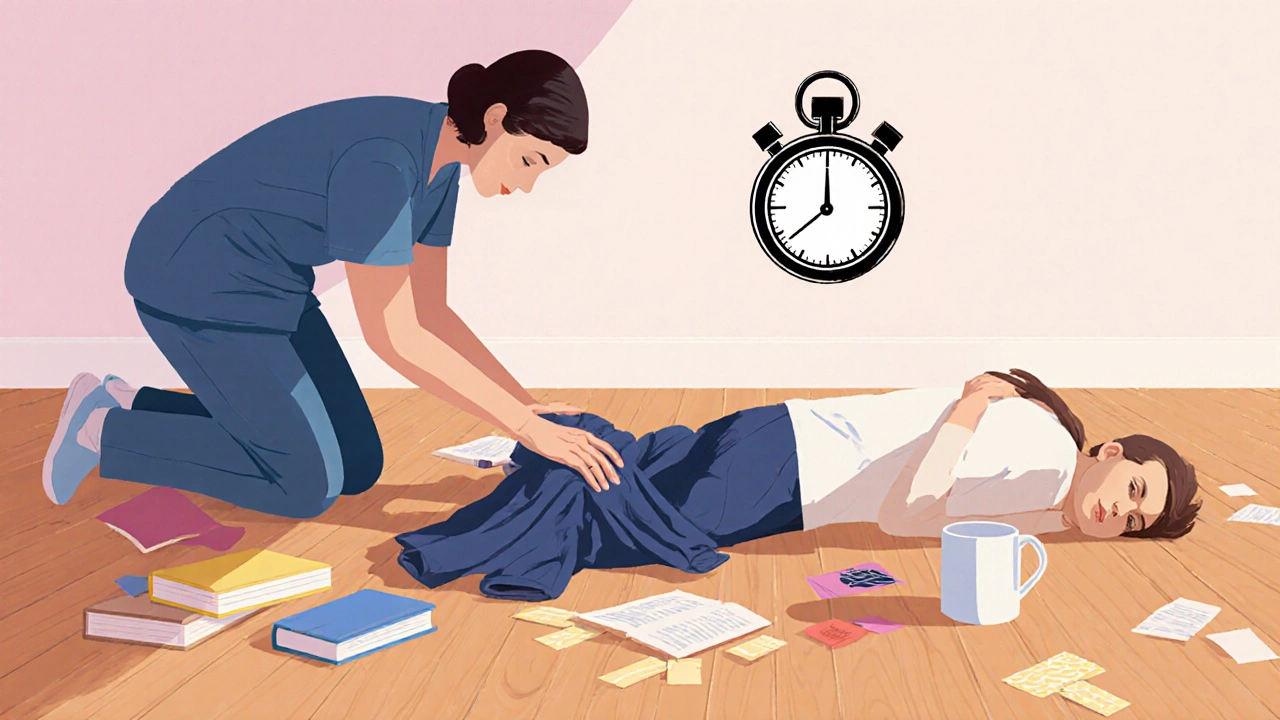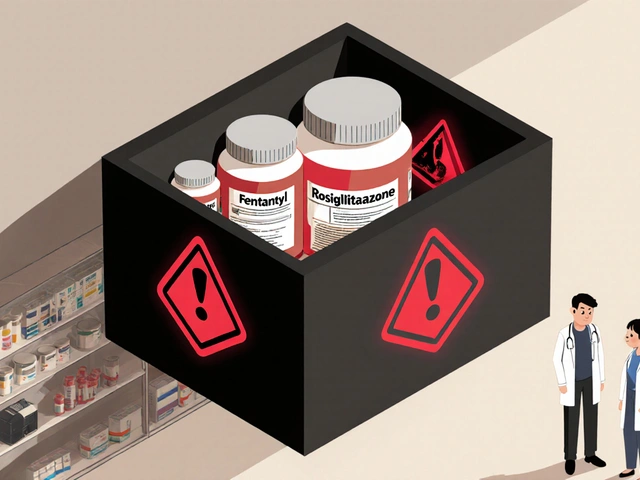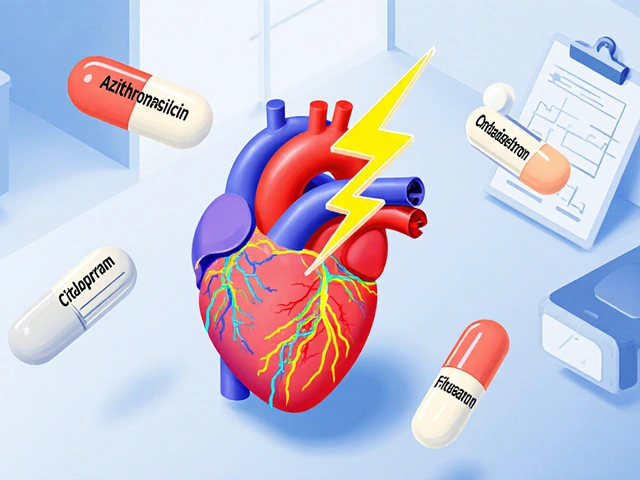First Aid Guide for Managing Partial Onset Seizures

Partial Onset Seizure First Aid Guide
Recognizing Signs
- Sudden repetitive movement
- Unexplained sensory changes (smell, taste, flash)
- Brief loss of awareness
- Automatic behaviors (chewing, lip-smacking)
Red Flags
- Seizure lasts more than 5 minutes
- First seizure ever
- Person doesn't regain awareness
- Breathing difficulties or injury
- Stay with the person
- Clear area of sharp objects
- Place something soft under their head
- Time the seizure
- Restrain them
- Put anything in their mouth
- Leave them alone immediately
- Administer medication
Call 911 if seizure lasts over 5 minutes.
- Keep the person lying down until fully alert
- Offer reassurance and explain what happened
- Check breathing and pulse
- Stay with them for at least 30 minutes
- Document seizure details for medical professionals
Quick Reference Checklist
- Stay with person
- Clear area
- Time seizure
- Call 911 if needed
- Don't restrain
- Don't put anything in mouth
- Don't leave alone
- Don't give meds
Imagine a loved one suddenly pauses, looks dazed, or starts making odd movements. It could be a partial onset seizure, a type of seizure that begins in a small area of the brain. Knowing exactly what to do in those first minutes can keep the person safe and calm the situation.
Quick Takeaways
- Keep the person safe: move objects, cushion the head, and stay calm.
- Don’t restrain them or put anything in their mouth.
- Time the episode; call emergency services if it lasts over 5 minutes or if it’s the first seizure.
- Provide post‑seizure care: comfort, monitor breathing, and note what happened.
Partial onset seizure is a type of seizure that starts in a localized region of the brain and may or may not affect consciousness. While many people think all seizures look the same, partial onset seizures can be subtle-an odd smell, a brief hand twitch, or a sudden lapse in awareness. Understanding those signs is the first step in effective first aid.
Recognizing a Partial Onset Seizure
Not every strange behavior means a seizure, but certain clues point strongly toward a partial onset event. Look for:
- A sudden, repetitive movement of one arm, hand, or facial muscle.
- Unexplained sensory changes-like a strange odor, taste, or visual flash-known as an Aura a warning sign that a seizure is about to start.
- Brief loss of awareness or a “spacing out” episode that lasts seconds.
- Automatic behaviors such as lip‑smacking, chewing, or repetitive picking.
Because these episodes can be short, they’re often missed. If you suspect a seizure, treat the situation as if it were a full seizure until you’re sure.
Immediate Safety Steps
When you see a possible partial onset seizure, act quickly but gently:
- Stay with the person. Your presence can prevent injury and reduces panic.
- Clear the area. Move chairs, books, or sharp objects out of the way.
- Guide the person to a safe surface, like the floor, and place a folded jacket or pillow under their head.
- Do not try to hold them down or restrain the movements.
- Do not put anything in their mouth-this is a common myth and can cause choking.
These steps are part of First aid immediate assistance given before professional care arrives aimed at preventing injury during a seizure.
When to Call Emergency Medical Services
Most partial onset seizures end on their own within a minute, but there are red flags:
- The episode lasts longer than 5 minutes.
- The person does not regain full awareness after the event.
- It’s their first seizure ever.
- You notice a new injury, difficulty breathing, or the seizure spreads to involve the whole body (possible progression to a Status epilepticus a medical emergency where seizures continue without full recovery).
Dial 911 (or your local emergency number) and tell the dispatcher you’re dealing with a seizure, how long it’s lasted, and any known medical conditions.

Post‑Seizure Care (The Postictal Phase)
After the movements stop, the person enters the post‑ictal phase. They may be confused, sleepy, or have a headache. Here’s what to do:
- Keep them lying down for a few minutes until they’re fully alert.
- Offer reassurance; speak calmly and explain what happened.
- Check breathing and pulse; if abnormal, be ready to give rescue breathing or CPR.
- Stay with them for at least 30 minutes, especially if they’re not returning to their baseline.
- Document the seizure: time, duration, observed symptoms, and any triggers.
This information is valuable for the person’s neurologist or primary care doctor, especially if the seizure was unexpected.
Common Mistakes to Avoid
Even well‑meaning helpers can unintentionally make things worse. Avoid these pitfalls:
- Holding the person’s tongue or forcing the mouth open.
- Giving medication without a prescription.
- Leaving the person alone immediately after the seizure.
- Assuming a seizure is “all in their head” and not seeking medical advice.
Remember, the goal of partial onset seizure first aid is safety, calm, and clear information for professionals.
Quick Checklist for Caregivers
| Do | Don’t |
|---|---|
| Stay with the person and speak softly. | Leave the scene unless you’re in danger. |
| Clear the area of sharp objects. | Try to physically restrain the movements. |
| Time the seizure. | Put anything in the mouth. |
| Call EMS if it lasts >5min or spreads. | Give over‑the‑counter meds without guidance. |
| Document details after the event. | Assume it’s harmless without a medical check. |
Having this list on hand-printed or saved on your phone-makes it easier to act fast.
Understanding the Bigger Picture
Partial onset seizures are a symptom of Epilepsy a chronic neurological disorder characterized by recurrent seizures. While many people manage them with medication, lifestyle changes, and regular doctor visits, emergencies still happen. Educating family, friends, and coworkers creates a supportive network that reduces anxiety and improves outcomes.
Frequently Asked Questions
How can I tell if someone is having a partial onset seizure?
Look for brief, repetitive movements, sensory changes (like a strange smell or visual flash), or a momentary loss of awareness. These signs may last only a few seconds, so observe quietly and note any patterns.
What should I never do during a seizure?
Never restrain the person, never put anything in their mouth, and never leave them unattended until they’re fully recovered.
When should I call 911?
Call emergency services if the seizure lasts more than 5 minutes, if it’s the first seizure, if the person doesn’t regain awareness, or if you notice breathing difficulties or injury.
How long can a partial onset seizure last?
Most partial seizures end within a minute, often under 30 seconds. If it goes beyond 5 minutes, treat it as a medical emergency.
Can a partial seizure turn into a generalized seizure?
Yes. In some cases, a partial seizure spreads to involve both brain hemispheres, leading to a tonic‑clonic (generalized) seizure. Monitoring duration and symptoms helps decide when to intervene.
What steps should I take after the seizure ends?
Keep the person safe, check breathing, offer reassurance, note details (time, duration, behavior), and stay with them until they’re fully alert. If any concerns remain, seek medical advice.






Comments (8)
Suzette Muller
3 Oct 2025
Great overview! The checklist you’ve put together covers the essentials, especially clearing the area and timing the episode-those details can make a huge difference in a chaotic moment.
siddharth singh
14 Oct 2025
When a partial onset seizure strikes, the first instinct is often to panic, but structured action can prevent secondary injury and reduce the person’s anxiety. The brain region involved dictates the motor or sensory manifestations, so recognizing subtle signs early is crucial. A sudden, repetitive hand twitch or an unexplained smell can be the aura that precedes the seizure. By noting these prodromal cues, rescuers can prepare the environment before the motor activity escalates. Clearing the vicinity of sharp objects should happen within seconds, and positioning a soft cushion under the head provides immediate protection. It is equally important not to restrain the limb movements, as forced immobilization can increase muscular stress and potentially trigger a generalized seizure. The myth of placing objects in the mouth has persisted for decades, yet it carries a risk of dental damage or airway obstruction, which is why the guideline emphatically advises against it. Timing the seizure with a watch or phone allows responders to report precise duration to emergency services, a detail that influences triage decisions. If the event persists beyond five minutes, a status epilepticus scenario may be unfolding, and rapid medical intervention becomes lifesaving. During the episode, maintaining a calm voice and gentle reassurance helps to stabilize the person’s autonomic response. After the convulsive activity ceases, the post‑ictal phase can involve confusion, drowsiness, or a headache, and the caregiver should keep the individual lying down until full orientation returns. Monitoring breathing and pulse during this period is essential; any irregularities should prompt immediate CPR or advanced support. Documentation of the seizure-time of onset, duration, observed behaviors, and potential triggers-forms a valuable record for neurologists, facilitating medication adjustments and further evaluation. In many cases, sharing this information with the person’s healthcare team leads to better seizure control and quality of life. Finally, educating family, friends, and coworkers about these steps builds a supportive network that reduces stigma and empowers everyone involved.
Carl Mitchel
25 Oct 2025
It’s not enough to just “stay calm”; we have a responsibility to follow evidence‑based protocols and not rely on outdated myths that endanger lives.
cris wasala
5 Nov 2025
Every life saved starts with a simple step forward
Tyler Johnson
16 Nov 2025
Looking at the guide holistically, I appreciate the balance between immediate safety actions and the longer post‑ictal care, especially the emphasis on staying until the person regains full awareness. The checklist format is user‑friendly, and the inclusion of red‑flag criteria helps to triage emergencies without overreacting. It’s also worth noting that caregivers should be aware of the person’s typical seizure pattern, as deviations may signal complications. The guidance to document the event in detail not only assists medical professionals but also empowers the patient by giving them concrete data to discuss with their neurologist. Overall, the resource strikes a good middle ground between brevity and depth, making it suitable for both laypersons and more experienced caretakers.
Josh SEBRING
27 Nov 2025
Well, if you’re going to write a “quick guide” you might as well admit that most people will just ignore it and hope for the best anyway.
Parth Gohil
8 Dec 2025
From a systems‑engineering perspective, the protocol aligns with risk mitigation frameworks; you isolate hazards, apply barrier controls, and then perform a post‑incident debrief. The language is approachable yet peppered with clinical terminology that ensures both novices and seasoned first‑aid providers can map the steps onto existing cognitive models.
VAISHAKH Chandran
19 Dec 2025
One must recognize that such simplistic checklists, while benign, fail to address the nuanced neurophysiological cascade inherent in focal epileptiform discharges.